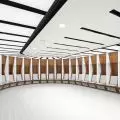article taken from A&B issue 4|24
What are the most important challenges for the near future, in the context of landscape design? Katarzyna Kobierska, landscape architect and founder of the KA KOBIERSKA design studio in Wroclaw, answers this question.
Katarzyna KOBIERSKA - landscape architect, founder of the KA KOBIERSKA design studio in Wroclaw, which deals with the design of public spaces. Winner of competitions and author of studies, implementation projects with NBS solutions, including rainwater management. In her work she pays special attention to the use of the engineering potential of ecological solutions, design in harmony with nature, habitat, respect for the existing place, cultural and natural resources, economy of form. She is a co-laureate of the third prize(ex aequo) in the FUTUWAWA 2021 competition "How will we live in Warsaw of the future?" for her work Warsaw SZEPT, and a co-laureate of the IFLA international competition "Boldness&Beauty" for her realized public space PoPo Park in Wroclaw. As of June 2022, she is a member of the Board of Directors at the Landscape Architecture Association.
non-stimulating
In an over-stimulated urban environment, over-stimulating our senses, we should start considering simplicity, legibility and integrity in shaping space and avoid over-stimulating elements. Concerned about potential sensory overload and mindful of increasingly diagnosed neuroatypical personalities, our designs should avoid over-stimulating shapes, colors and functions.
A piece of furniture referring to the identity of the place, avoiding overstimulation due to the neighboring school facility attended by neuroatypical children - Poznań, Mood for Wood, edition August 2023 - workshop organized by SARP O. Poznań, Common Point Association tutors: Nils Wenk, Katarzyna Kobierska authors: workshop participants: Roman Michalczak, Michał Pietrusiewicz, Ibrahim Kandeel, Leo Altmann, Michaela Kirnerová, Marina Alimpieva, Roxana Dziurowicz, Marcin Stępień, Oliwia Kłopatowska, Julia Bugajska, Daria Kaczmarzewska, Paweł Siemaszko, Maciej Misiak, Willy Manford, Mikołaj Gniadzik, Anastasiia Antonova, Mareike Finnern, Nastassia Mitrafanava, Natalie Polakova, Julia Jura, Karolina Staszewska, Anna Leonik
Photo: Mikolaj Gniadzik
Site identity, cultural layer
Globalization and disappearing cultural values further motivate people to reach for perpetuating the traditions of a place, a region in the development of space. It is becoming increasingly important to preserve the existing natural and scenic, architectural qualities, to refer to the history, tradition and culture of the place, to fit in with the aesthetics of the surroundings with the design. Highlighting the assets and distinctive features of the space, bringing out the spirit of the place.
Protection
In a compact urban space, it becomes crucial to protect the existing low and high greenery on the site, appropriate provisions in the design and recognition of the health of trees, and above all, appropriate protection during construction. Relocation of greenery sites, for example, meadow seed collection, planting and nursery of existing greenery before construction and reseeding them, planting them after construction, so-called greenery recycling or ecosystem restoration. These are serious challenges that landscape architects are currently facing.
Education
Education from an early age in promoting understanding and acceptance of the aesthetics of natural disorder in nature cannot be overestimated. Education from an early age, not only through the use of half-measures such as ready-made insect houses, but also by showing natural habitats for animals and microorganisms, such as dry stumps, left patches of uncovered ground for bees to make underground nests, piles of branches for hedgehogs, and wild thickets and thickets for birds. The example should come first and foremost from the top, and trends and standards should be set by state and local managers. How we manage greenery in a city should come from knowledge, professional practice, scientific research and proven solutions, not from the preferences of an individual. Landscape design is a responsible role, it is not just about considering aesthetics and functionality.
Tarnogaj Park, Lesne Druhy Tarnoduchy - in the project, the most important thing was to adapt the recreation yard to the existing stand of trees in order to preserve it, limit the stimulus of colors and materials and refer to the identity of the place - Tarnogaj estate and former cemetery in Wroclaw investor: ZZM Wrocław authors: PROMART Wioletta Trytko in cooperation with KA KOBIERSKA contractor: Tribud realization: 2021
photo: Katarzyna Kobierska
aesthetics of natural disorder
An ongoing issue, now especially timely, seems to be the analysis of the meaning and beauty of natural disorder in ecosystems and the consequences of unsustainable practices in the landscape. Educating leads to understanding the aesthetics of nature's natural disorder. By educating ourselves about dead trees as biodiversity hotspots providing homes for countless species of insects, beetles and microorganisms, we are able to accept the aesthetics of decay as a necessary element to close the cycle of matter in nature.
We must also understand that in nature simple neat edges do not exist, the intermingling of habitats, the mixing of species at the interface of ecotones are natural and beautiful phenomena. The disorder of nature has its own complex systematics, which allows plants to function in the form of sustainable ecosystems. Commonly used materials in horticulture, such as ecoborders marking out even, unnatural edges, non-woven fabrics lining beds to keep unwanted plants from overgrowing them, cause this natural balance to be upset. The reason for all unnatural activities in the landscape is the lack of acceptance of the natural aesthetics of disorder, which is the result of a lack of education.
Tarnogaj Park, Lesne Druhy Tarnoduchy - in the project the most important thing was to adapt the recreation yard to the existing stand of trees in order to preserve it, limit color and material stimuli and refer to the identity of the place - Tarnogaj estate and former cemetery in Wroclaw investor: ZZM Wrocław authors: PROMART Wioletta Trytko in cooperation with KA KOBIERSKA contractor: Tribud realization: 2021
photo: Katarzyna Kobierska
management, failure to act
In landscape design it is important to seek a balance between wildness and interference. The future of landscaping lies in the proper management of designed and existing greenery, in the search for a balance between the wild, where we are able to almost completely abandon our activities, and the nurtured, cultivated.
A customized approach to managing invasive plant species in the context of landscape design
Invasive alien species (IGOs) are controversial among biologists, naturalists, but in difficult conditions: in the strict center of the city, where the substrate is a post-construction embankment and the remains of paved surfaces, they often constitute the only form of vegetation cover of the area. In the case of invasive species, the approach must always be individual. We will treat differently a tree from an invasive species that has already reached a significant size in the inner city, where it is one of several trees that can be preserved on the site, differently in a more densely wooded space. Existing invasive species, as pioneer species, properly managed can be a valuable site resource. The mere fact of cutting down a several-meter-tall tree and then purchasing, transporting and then watering for several years another planted instead raises some ecological dilemmas. Another issue is the design of new greenery selections, where we should always consider native species first. Many of them can withstand extreme conditions, but they always require maintenance inputs at the beginning, if only a few years of watering. This is why it is so important - and cheapest - to protect existing greenery and consider each case individually.
ecological engineering
Ecological engineering is an underestimated field in the sphere of landscape architecture, and can be one of the elements of circular design. Natural slope reinforcement with fascines, vegetation rollers, wicker fences, or live fascines and young shrub cuttings, so-called cuttings, is the most ecological and proven engineering solution. We can obtain these elements from plants found in the area. As they decompose, they join the natural cycle of matter in nature. Germany, from whose knowledge we can and should take handfuls, is at the forefront in such solutions, also supported by scientific engineering calculations.
Circularity in the form of retention and the nature of disorder and the disorder of nature in the Port Popowice Connector in Wroclaw (fragment from the side of the renovated street under construction) - investor: Vantage Development leading landscape architect: Kamila Rogaczewska design: KA KOBIERSKA Katarzyna Kobierska architectural design: TECLA - Architecture and Urban Planning realization: 2022
photo: Katarzyna Kobierska
circularity in landscape design
Circularity in the context of landscape design is primarily a return to the roots and old horticultural practices, such as the creation of soil, for example, foliage, own compost, cultivation of raised beds in the form of Hügelkulture, permaculture, use of environmentally benign materials found on the plot, rainwater retention, anticipation and planning of the development of space and its dynamics. The element of circularity in nature has existed for a long time, it is the circulation of matter, so by designing in harmony with nature and understanding its mechanisms, we are able to introduce the aspect of circularity in our design.
challenges of using artificial intelligence
It also seems to be a challenge to work closely with increasingly specialized industry professionals, as well as machines and artificial intelligence for site analysis and design. Using parametric objects for landscape design - carefully and respecting natural processes - is becoming an increasingly useful solution.




























